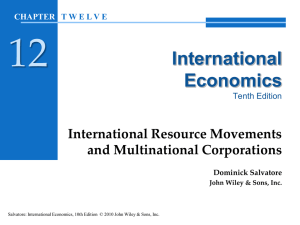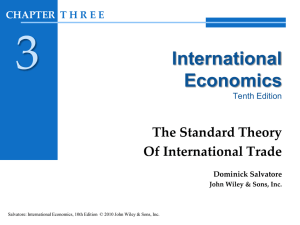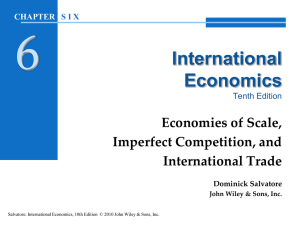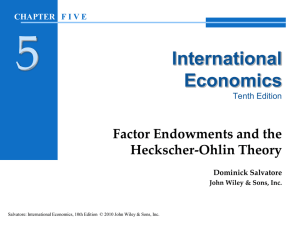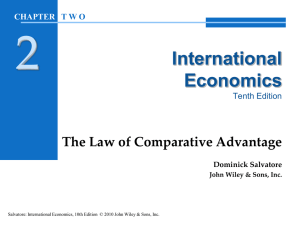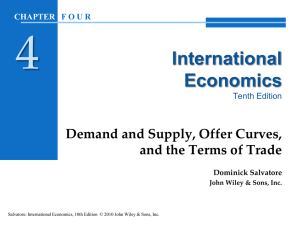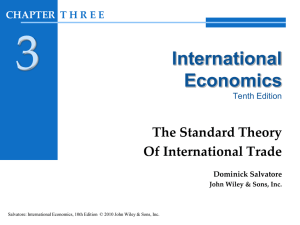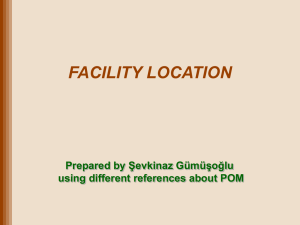Imperfect Competition and International Trade
advertisement
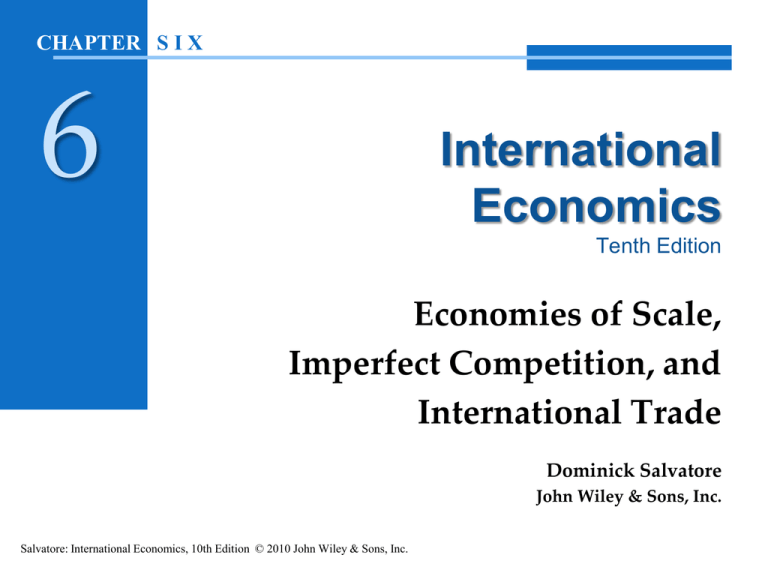
CHAPTER S I X 6 International Economics Tenth Edition Economies of Scale, Imperfect Competition, and International Trade Dominick Salvatore John Wiley & Sons, Inc. Salvatore: International Economics, 10th Edition © 2010 John Wiley & Sons, Inc. In this chapter: Introduction The Heckscher-Ohlin Model and New Trade Theories Economies of Scale and International Trade Imperfect Competition and International Trade Trade Based on Dynamic Technological Differences Costs of Transportation, Environmental Standards, and International Trade Salvatore: International Economics, 10th Edition © 2010 John Wiley & Sons, Inc. Introduction Heckscher-Ohlin theory based comparative advantage on differences in factor endowments among nations. Leaves significant portion of international trade unexplained. Need complementary trade theories to fill in the gaps. Salvatore: International Economics, 10th Edition © 2010 John Wiley & Sons, Inc. The Heckscher-Ohlin Model and New Trade Theories Relaxing most assumptions of H-O theory modifies but does not invalidate the theory. However, relaxing assumptions of perfect competition and constant economies of scale require complementary theories to explain trade. Additional trade model required to explain trade based on differences in technological changes over time. Salvatore: International Economics, 10th Edition © 2010 John Wiley & Sons, Inc. Economies of Scale and International Trade Increasing returns to scale Production situation where output grows proportionately more than the increase in inputs (doubling inputs more than doubles output). With increasing returns to scale, mutually beneficial trade can occur even if nations are identical in every way. Salvatore: International Economics, 10th Edition © 2010 John Wiley & Sons, Inc. FIGURE 6-1 Trade Based on Economies of Scale. Salvatore: International Economics, 10th Edition © 2010 John Wiley & Sons, Inc. Economies of Scale and International Trade Increasing returns to scale Significant international economies of scale from: Outsourcing – purchase by firm of parts and components abroad in order to keep costs down. Offshoring – firm producing in its own plants abroad some of the parts and components used in its products. Salvatore: International Economics, 10th Edition © 2010 John Wiley & Sons, Inc. Imperfect Competition and International Trade International trade can involve the exchange of differentiated products of the same industry or broad product group. Leads to intra-industry trade in differentiated products, as opposed to interindustry trade in completely different products. Allows economies of scale in production. Salvatore: International Economics, 10th Edition © 2010 John Wiley & Sons, Inc. Imperfect Competition and International Trade Contrasts to H-O Model 1. Trade in H-O model based on factor endowment differentials, but intra-industry trade is based on product differentiation and economies of scale, and will likely be larger for nations of similar size and factor proportions. 2. With differentiated products produced under economies of scale, pretrade-relative commodity prices may not accurately predict patterns of trade as they do under H-O model. Salvatore: International Economics, 10th Edition © 2010 John Wiley & Sons, Inc. Imperfect Competition and International Trade Contrasts to H-O Model 3. H-O model predicts trade will lower returns of nation’s scarce factor. With intra-industry trade based on economies of scale, it is possible for all factors to gain. 4. Intra-industry trade is related to sharp increases in international trade in parts and components of a product, or outsourcing. Salvatore: International Economics, 10th Edition © 2010 John Wiley & Sons, Inc. Imperfect Competition and International Trade Comparative advantage seems to determine patterns of inter-industry trade. More likely with dissimilar factor endowments. Economies of scale in differentiated products gives rise to intra-industry trade. More likely with similar factor endowments. Salvatore: International Economics, 10th Edition © 2010 John Wiley & Sons, Inc. Imperfect Competition and International Trade Intra-industry Trade Index (T): |X - M| T=1- X+M X = exports M = imports Numerator is absolute value T ranges from 0 to 1 T=0 when nation only imports or exports the good T=1 when exports = imports. Salvatore: International Economics, 10th Edition © 2010 John Wiley & Sons, Inc. FIGURE 6-2 Production and Pricing Under Monopolistic Competition. Salvatore: International Economics, 10th Edition © 2010 John Wiley & Sons, Inc. FIGURE 6-3 Monopolistic Competition and Intra-Industry Trade. Salvatore: International Economics, 10th Edition © 2010 John Wiley & Sons, Inc. Trade Based on Dynamic Technological Differences Product Cycle Model (Vernon, 1966) Advanced industrialized countries develop and introduce new products, with temporary monopoly power as the sole exporter of the product. As the technology producing the product becomes more widespread, production will spread to other nations. This moves international trade to a standard comparative advantage framework Salvatore: International Economics, 10th Edition © 2010 John Wiley & Sons, Inc. Trade Based on Dynamic Technological Differences Product Cycle Model (Vernon, 1966) As production becomes standardized, the original introducer of the product loses its technologically based comparative advantage in the production of the product and becomes an importer of the product. Salvatore: International Economics, 10th Edition © 2010 John Wiley & Sons, Inc. FIGURE 6-4 The Product Cycle Model. Salvatore: International Economics, 10th Edition © 2010 John Wiley & Sons, Inc. Costs of Transportation, Environmental Standards and International Trade Transportation costs Transport, or logistics, costs are the freight charges, warehousing costs, costs of loading and unloading, insurance premiums, and interest charges incurred while goods are in transit between nations. Homogeneous goods will be trade internationally only if the pretrade price difference exceeds transport costs. Salvatore: International Economics, 10th Edition © 2010 John Wiley & Sons, Inc. Costs of Transportation, Environmental Standards and International Trade Transportation costs Nontraded goods and services are goods for which transport costs exceed price differences across nations. Examples: Cement is not traded internationally because of its high weight-to-value ratio. Average people do not travel from New York to London for a haircut. Salvatore: International Economics, 10th Edition © 2010 John Wiley & Sons, Inc. Costs of Transportation, Environmental Standards and International Trade Two ways to analyze transport costs General equilibrium analysis Uses production frontiers or offer curves, and expresses transport costs in terms of relative commodity prices. Partial equilibrium analysis Analyze absolute cost by holding constant exchange rates, income, and all else in the two nations except amount of good produced, consumed and traded. More straightforward method than general equilibrium analysis. Salvatore: International Economics, 10th Edition © 2010 John Wiley & Sons, Inc. FIGURE 6-5 Partial Equilibrium Analysis of Transport Costs. Salvatore: International Economics, 10th Edition © 2010 John Wiley & Sons, Inc. Costs of Transportation, Environmental Standards and International Trade Transport costs influence location of production and industry: Resource-oriented industries locate near the source of raw materials used by the industry. Market-oriented industries produce goods that become heavier or more difficult to transport during production, so they locate near the markets for their products. Footloose industries face neither substantial weight gains nor losses during production, and can locate where availability of other inputs leads to lower manufacturing costs. Salvatore: International Economics, 10th Edition © 2010 John Wiley & Sons, Inc. Costs of Transportation, Environmental Standards and International Trade Environmental standards Refers to levels of air, water and thermal pollution resulting from garbage disposal that a nation allows. A nation with lower environmental standards can use the environment as a resource endowment, achieving comparative advantage in polluting goods and services. Salvatore: International Economics, 10th Edition © 2010 John Wiley & Sons, Inc. Appendix to Chapter 6 External Economies and Specialization The Learning Curve and Specialization Salvatore: International Economics, 10th Edition © 2010 John Wiley & Sons, Inc. FIGURE 6-6 External Economies and Specialization. Salvatore: International Economics, 10th Edition © 2010 John Wiley & Sons, Inc. FIGURE 6-7 The Learning Curve and Specialization. Salvatore: International Economics, 10th Edition © 2010 John Wiley & Sons, Inc.

